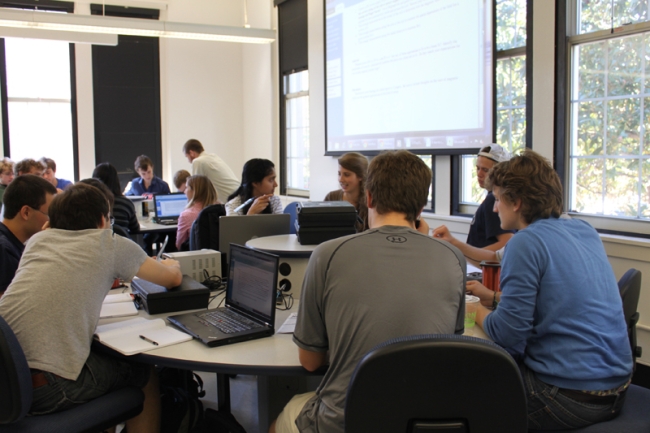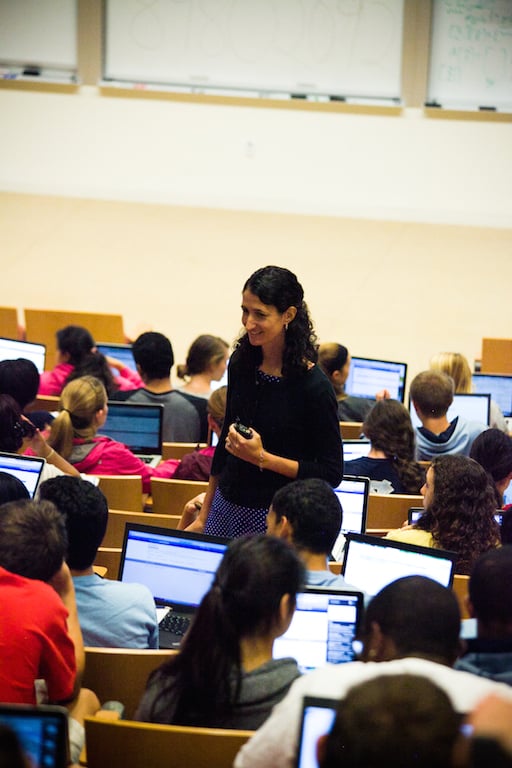You have /5 articles left.
Sign up for a free account or log in.

An undergraduate physics class at the University of North Carolina at Chapel Hill, which is involved in AAU's undergraduate science initiative.
The University of North Carolina at Chapel Hill
It’s no secret that science courses, particularly at the first- and second-year levels, can be dry. The classes are big, the content is wide but typically shallow, and professors often resort to lectures. There’s a lot of talk among science educators about how to make these courses more interesting, to attract students and retain them as majors, but much of the conversation thus far has focused on improving individual faculty members’ teaching. And that’s not a bad thing: one innovative teacher in a department is better than none.
But that approach relies more on a ripple effect than seeking to change the tide. And many faculty members at research universities report that they have a tough time getting higher-ups' attention for anything but research and securing grant money, making teaching a decidedly lower priority.
The Association of American Universities, a group of 62 leading public and private research institutions, wanted to do something about science education on a bigger scale. So in 2011, it launched the Undergraduate STEM Education Initiative to encourage systemic improvements to science education. As AAU program officers and other scholars wrote last month in a Nature article on revamping science education, the initiative is “based on understanding the wider setting in which educational innovations take place -- the department, the college, the university and the national level.” It “emphasizes the separate roles of senior university administrators (who can implement top-down change), individual faculty members (bottom-up change) and departments (change from the middle out), all of which are necessary for sustained institutional improvement to undergraduate STEM teaching and learning.”
Emily Miller, an AAU senior program officer overseeing the initiative, said in an interview that it was inspired by “growing body of evidence of how to effectively engage students in the learning of math and sciences, and the need to think about how to help and support and acknowledge the faculty members at [major research institutions] who are improving undergraduate education.”
She added, “How do you bring a balance to teaching and research when at these institutions the incentive structure is based very much around the research?”
So what does all that look like on the ground? Snapshots of a few universities’ progress show there’s no one way to eat an elephant.
The University of North Carolina at Chapel Hill
Kelly Hogan, a senior lecturer of biology at the University of North Carolina at Chapel Hill -- where biology, chemistry and physics are involved in the AAU initiative -- loves teaching. But she doesn’t particularly like being at the front of the class. In fact, she finds the sage-on-the-stage-type lecture as tiring as many of her students appear to. So she keeps her introductory biology students on their toes even if they’re in their seats with active learning exercises designed to increase their scientific literacy skills -- graphing data, evaluating study design, making conclusions and communicating with peers.
Here’s an example prompt:
“In a study looking at the effectiveness of laser therapy acne treatment, 19 individuals were chosen to participate because they had at least five pimples. After the first laser treatment, participants exhibited a significant reduction in the average number of pimples. After the second treatment, another reduction in the average was found, and after the third treatment an even further reduction was found.”
Does laser therapy work to treat acne? After drawing a graph of the data, students use a “bring your own device” software program called Learning Catalytics to report their findings.
Initially, 21 percent of students say yes to laser therapy as effective treatment. But after conferencing with peers -- quite willingly, even a massive lecture hall -- only 5 percent say it’s effective. Back in their peer groups and later, in a class discussion, students articulate some to the problems with the study, such as that it has no control and small sample size.
Acne not your thing? Hogan’s got a slew of other prompts on everything from ecology to evolution. Of course, the prompt at this point is far less important than the process -- the active learning and engagement of gateway science students that the AAU wants to foster. And AAU’s initiative being what it is, this isn’t really about Hogan, either. Rather, she and other teaching-focused faculty members are coaching a group of volunteer professor “apprentices” -- some of them senior, tenured members of the science faculty -- to shake up their teaching in ways that will keep students in the sciences throughout their college and university careers.

Two years into the project, 15 apprentices have been trained by nine mentors. Apprentices get a formal course release in their first semester for training. Beyond that, apprentices are visited and observed by their mentors and participate in faculty learning community discussions for several more semesters.
Michael T. Crimmins, the Mary Ann Smith Professor of Chemistry at Carolina, was one of the first senior faculty members to join the AAU initiative as an apprentice, and he’s now a mentor. He was paired with a much more junior instructor with expertise in active learning methods who mentored and team taught with him. He also developed a series of short concept videos for his students to watch before they came to class.
“We’re trying to get students to engage with content multiple times, to get some information before they come to the classroom,” he said. “Then I’m a lot less of a lecturer than I used to be. … The huge change is that I don’t walk into class with notes or a PowerPoint -- I have some notes -- but it’s not me talking, talking, talking. I talk a little bit but I’m posing students questions, and they’re talking among themselves or in groups.”
For the first few semesters, Crimmins said preparing to teach class this way was a lot of work. And time constraints -- beyond ego or comfort -- are probably the biggest barriers for professors in changing up their teaching, he said. But two years later, the investment is worth it. “I love this,” he said.
Other departments within the College of Arts and Sciences, including in the humanities, have begun to express interest in the initiative, which Crimmins called “transformational.”
“That’s really what we were trying to do from the beginning -- to try to effect a culture change,” he said.
Kevin Guskiewicz, senior associate dean for the natural sciences at Carolina, said the mentor-apprentice approach to teaching active learning pedagogy already has reaped some measurable results.
In introductory biology, for example, first-generation college students -- traditionally those who tend to struggle in big, introductory science courses -- closed the achievement gap. Black students halved the gap with a 6-7 percent increase in their final exam scores compared to those who took the unmodified course five years ago. Latino students also are seeing some gains, but determining whether those gains are meaningful or not requires more analysis.
Guskiewicz said he believes the initiative also has helped more women enroll in gateway science courses; campuswide, women now make up 63 percent of gateway science students, compared to lower numbers in the past. Time will tell whether they remain as majors, he said. And the university wants to study further whether the modified course has improved learning for all students, not just higher-risk groups.
“This is a culture shift -- there are people here who think that the culture that exists is fine, they’re traditionalists,” Guskiewicz said. “And looking at the data is one way we’re trying to change the culture, by embracing tradition but trying to find ways to improve.”
Hogan agreed that evidence is key to recruiting new apprentices (there are eight signed up for this year). “When you’re trying effect a culture shift, you have your change agents, your supporters and your skeptics,” she said.
Michigan State University
While North Carolina focused on teaching first, and later narrowed down content to make room in the course for innovative teaching and active learning, faculty members involved in the AAU initiative at Michigan State University started at the other end. Melanie Cooper, the Lappan-Phillips Professor of Science Education in the department of chemistry, said she and her colleagues are focusing first on what content is essential to their courses.
“Often other efforts are focused on changing how faculty conduct the class, to encourage more active learning and student engagement,” said Cooper, who’s heading up Michigan State’s initiative involving gateway courses for students in chemistry, physics and biology. “But it’s quite difficult to get faculty’s attention that way, particularly research faculty who have a lot of demands on their time. What we wanted to do was see if we could get faculty to talk about what’s important.”
Research suggests that gateway courses -- with their mile-wide, inch-deep approaches -- can be a turn-off to students, Cooper said. So the idea was to make these gateway courses a little more narrow and meaningful to retain students’ interest. “Ideally what we’d like is to be where students were actively engaged and developing useful, robust knowledge -- not just memorizing and regurgitating and doing rote calculations,” she said.
Cooper helped convene working groups in each of the three disciplines (there’s also a cross-discipline working group), in which faculty members are working to identify the “core ideas” of each introductory course. It doesn’t represent a dumbing down but rather a prioritization of what matters, she said.
There haven’t been any coverage wars, mainly because professors decide for themselves what to keep and what to scratch, Cooper said. And the 20 or so faculty members who attend meetings are there because they want to be.
“These are ongoing conversations and the faculty own the curriculum, but what we’re trying to do is use the core idea of the disciplines and these overarching ideas, and saying if what we’re teaching doesn’t support these core ideas, then we don’t need to teach it,” she said.
Inevitably, from these discussions emerge conversations about how to most effectively teach the core ideas, Cooper said. “You can’t lecture about modeling phenomena and analyzing data -- students have got to do it.”
Cooper, for example, uses active learning methods in transformed gateway chemistry course sections with hundreds of students. She starts off by reviewing students’ homework samples anonymously with the class. Students revise and correct their own work and ask questions. There’s typically a short lecture, followed by an activity and student discussions. Instructors in the other transformed gateway courses have adopted similar methods.
Michigan State is still in the middle of its initiative, Cooper said, but will eventually gather and analyze data about student learning to see whether the efforts have made a difference -- especially for underrepresented students. The university also wants to study whether the initiative has made a difference in major retention rates.
Framework for Change
Eight universities are officially involved in the initiative and have received AAU seed funds with the support of the National Science Foundation and the Leona M. and Harry B. Helmsley Charitable Trust. Dozens more universities are interested: a spring workshop in Washington, for example, attracted some 60 department chairs from across the U.S. Speakers had different approaches to making their teaching more innovative -- the AAU initiative isn’t prescriptive -- but many examples were rooted in high-structure, active learning pedagogies. That is, active problem solving, analysis, synthesis, evaluation of content, even in big lectures, along with small-group learning. Classes are often flipped.
AAU’s developed a framework for systemic change in undergraduate STEM teaching to help guide universities in their work. In the center is pedagogy, with a focus on articulated learning goals that are made explicit to students; educational practices, such as engaging students in active learning, using real-world examples and letting data drive practice; assessments, including for hard-to-measure outcomes like scientific thinking and problem solving; and access (making sure that STEM courses are inclusive of all students).
Supporting pedagogy is scaffolding. That means providing faculty development of evidence-based teaching; providing faculty with easily accessible resources, such as learning tools and technology; collecting and sharing data on program performance; and aligning future facilities planning with modern instructional approaches.
Cultural change is the last part of the framework. That entails a leadership commitment on the part of the president and provost and distinguished faculty; establishing strong measures of teaching excellence, such as prioritizing teaching effectiveness in hiring decisions and basing teaching evaluations on more than just student feedback; and aligning incentives with the expectation of teaching excellence. According to AAU, teaching mastery should be a major part of the promotion and tenure process, for example, and efforts to promote teaching excellence should be counted in merit pay adjustments.
Miller, the AAU program officer, said there’s “great value in a undergraduate education at a research institution, where research and teaching are coupled. But we can do an even better job at that.”





